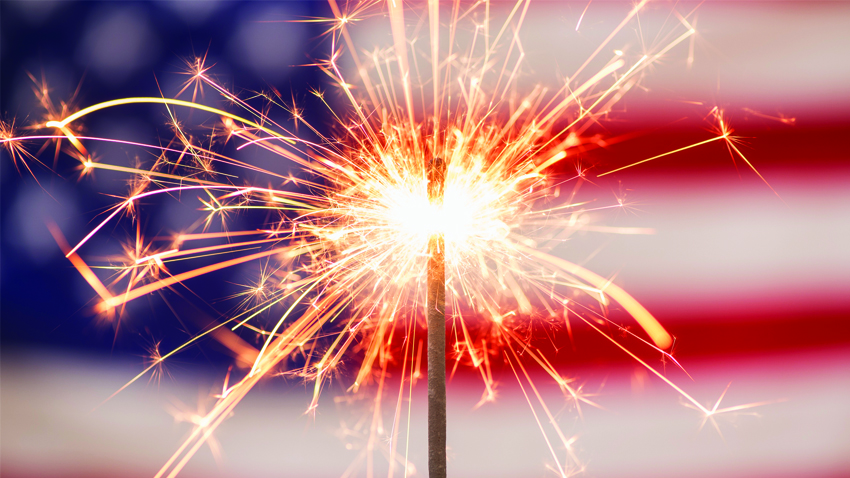Cast all your anxiety on him because he cares for you. 1 Peter 5:7
How to manage PTSD on the 4th of July
Americans celebrate our country’s birthday with parades, picnics and cookouts. For many, the fireworks are the “icing” on the cake of the 4th of July.
But for individuals with Post Traumatic Stress Disorder (PTSD), explosions and noisy displays can raise anxiety levels and bring back traumatic memories of gunfire, bomb detonations and terrifying conditions.
City or community firework shows aren’t usually the problem. Everyone knows when those shows are happening and they can plan accordingly.
But fireworks and illegal firecrackers set off randomly anywhere, at any time of the day or night can be the worst triggers for PTSD…especially those earth-shaking booms that send terrified pets scrambling under the bed.
In 2017, a non-profit organization, Military with PTSD, began taking steps to create a safer environment for our four million military veterans and other PTSD sufferers. The group sent out thousands of lawn signs with the words, “Combat Veteran Lives Here. Please be Courteous with Fireworks.” While the signs received popular interest, it will likely take time for Americans to adopt new attitudes about celebrating with less racket.
In the meantime, those with PTSD manage to find ways to handle their emotional well-being through situations that many others take for granted.
Steve Rolnick, PhD, a PeaceHealth psychologist in Eugene, Oregon, offers these nine practical tips to prepare and cope, if you suffer from PTSD.
9 Tips for Coping with a Noisy Holiday
1. Ask your neighbors to let you know if they plan to set off fireworks. Anticipating the noise can help you avoid being caught off guard. (If you’re uncomfortable talking with your neighbors about it, have a trusted friend or loved one check with them instead.) You might let others know you struggle with anxiety or PTSD and that fireworks can make it difficult on you. You can encourage them to celebrate the holiday as they wish, but just tell them it would help you to know when they expect to set off their fireworks.
2. Prepare a self-care tool kit. Consider positive things you can use for healthy distraction and comfort. Look through photographs that give you joy. Listen to favorite soothing music. Enjoy the fragrance of fresh pine, lavender, cinnamon or peppermint. Spend time playing with or grooming your dog or other pet.
3. Cover your ears. Wear inexpensive foam ear protection. When fireworks start with greater intensity or frequency, try other acoustic ear muffs or noise-cancelling earphones. Listen to calming music, an engaging audio book or nature sounds to cope with the noise. Run a fan or other source of white noise to help mask and muffle the outside sounds. Retraining can help you remove negative associations to loud sounds and help you begin to experience them as more neutral.
4. Darken your room. If flashes of light bother you when you’re trying to sleep, shut the blinds, use a room-darkening curtain and/or wear an eye mask or bandanna over your eyes.
5. Allow yourself to accept the reactions that you have. Don’t be self-critical, embarrassed or ashamed. Millions of people have startle and upset reactions. Remind yourself you are ok; these noises are temporary, and you are safe.
6. Plan to get away. While it may not always be possible or necessary to avoid the crowds and fireworks, consider going outside of the city or neighborhoods. Enjoying nature away from it all can be restorative. Watching a firework display from miles away, for example, on a distant beach with friends or family, might turn out to be an enjoyable experience.
7. Practice self-regulation and grounding techniques to help make your body and mind feel safe and more secure.
- For example, position yourself to keep your back against something hard like a wall or a chair, sit so you feel the solid support of the floor beneath your feet if you are starting to feel fearful and unsafe.
- Think about what makes you feel grounded and supported in other ways. Wear long sleeves and trousers. A favorite hat may also help you feel more protected.
- Practice S-L-O-W deep breathing. Emphasize breathing from the belly (diaphragm). Emphasize the duration of exhalation, breathing out nearly twice as long as breathing in. Breathe in to a slow count of three to four and exhale to a slow count of six to eight. Notice how the air entering your nose and mouth is cool and how it’s warm going out. Imagine blowing out candles on a cake as you do this.
- Notice your surroundings, look around and even if you feel unsafe, remind yourself that you are safe and not in harm’s way in your current surroundings. Describe to yourself what you see around you that can keep you grounded in your present reality.
- Practice a 5-4-3-2-1 sensory exercise to feel centered, grounded and calm. Identify
- Five things you can see
- Four things you can hear
- Three things you can feel
- Two things you can smell
- One good thing you are grateful for or can say about yourself.
- Practice mindfully eating a piece of fruit, noticing how it looks, the texture of its skin, the fragrance of its aroma, the temperature, flavor, and how it feels as you taste it. See how long you can enjoy each bite until you swallow it. Notice how it feels when you swallow each bite and before you take another.
8. Use some helpful phone apps to guide you. The National Center for Telehealth and Technology and the Veteran’s Administration National Center for PTSD has helped in the development of two effective, free apps for smartphones to help people cope better with symptoms of anxiety, panic and PTSD. One app is called Virtual Hope Box and the other is PTSD Coach.
9. Seek help. Should your symptoms persist, seek professional trauma-focused therapy to help cope with, reduce and eliminate these anxiety responses.


Seeking help
The National Center for Telehealth and Technology(link is external) and the Department of Veterans Affairs’ National Center for PTSD(link is external) have helped in the development of two free apps for smartphones to help people cope better with symptoms of anxiety, panic and PTSD. One app is called Virtual Hope Box(link is external)and the other is PTSD Coach(link is external).
If you are struggling with PTSD and want confidential guidance, you can call the Substance Abuse and Mental Health Services Administration (SAMHSA) National Helpline at 1-800-662-HELP (4357), or if you experience suicidal thoughts along with your PTSD episodes, call the National Suicide Prevention Lifeline at 1-800-273-8255.









